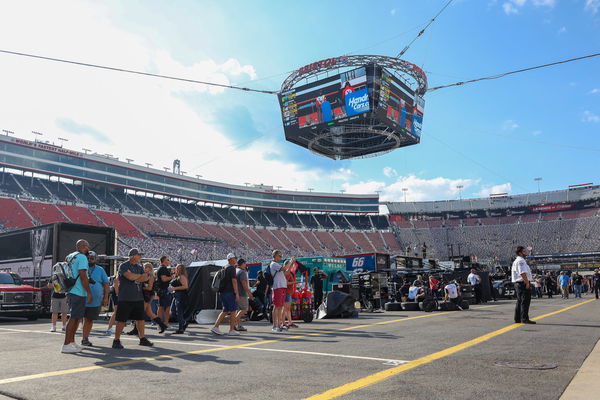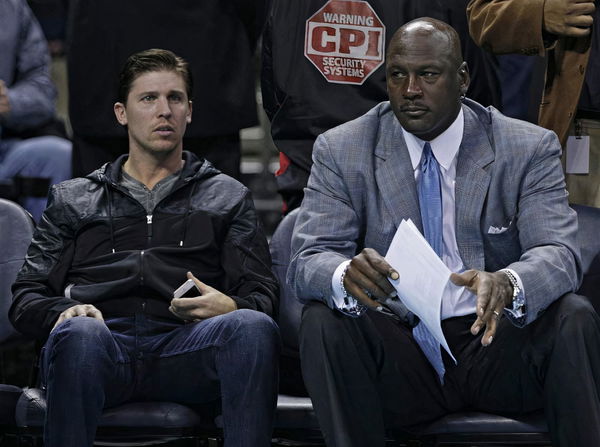NASCAR’s Point System Through the Years: Exploring the Never Ending Controversy

USA Today via Reuters
Sep 15, 2023; Bristol, Tennessee, USA; NASCAR fans watch from the pits during practice for the Bass Pro Shops Night Race at Bristol Motor Speedway. Mandatory Credit: Randy Sartin-USA TODAY Sports
Ask yourself this, how do you determine the best in a super-competitive sport laced with fierce drivers like NASCAR? Would you pick the most winningest driver of the season as the champion or would you consider the racer with the average finish as the best or is it the individual who can overcome adversity to win it at the big stage, say the final championship decider race? This is one question that has triggered so much controversy in the community so much so that the sanctioning body had to revise its points system across seven generations.
While the organization had to consider several variables to present an appealing product for its massive fanbase, in the process of doing so, NASCAR has sort of downplayed itself with rigorous revamping thus attracting criticism both from its fan community and its drivers alike.
Point system dilemma – How NASCAR’s point format has changed over the years
ADVERTISEMENT
Article continues below this ad
From the initial phase of the sport in 1949, NASCAR has constantly evolved its points format, making changes concerning the money earned, miles and laps run, a complicated one-year formula, the Latford system, the Chase, and the current elimination playoffs that is in effect today. Each of these systems has its own merits and demerits as drivers like Denny Hamlin and Darrell Waltrip have been vocal about NASCAR’s ineffective format of selecting the winner.
While the current system utilizes a playoff-style, elimination-rounder format that creates a sense of excitement in the community, this current layout also has its cons. It is designed in such a way that the initial phase of the tournament holds no value as drivers just need to pick off wins in the later half to propel themselves into the playoffs and further ahead by solely relying on points.
It was a good ride! https://t.co/zcPqkcbv79
— Kevin Harvick (@KevinHarvick) December 6, 2023
For instance, Michael McDowell who won the Indy500 did not make it to the playoff rounds because of the point deficit but 23XI Racing driver, Bubba Wallace who had zero wins cheekily secured the necessary points to make it past the regular season. The recent Kevin Harvick stats that emerged in the NASCAR nation are another example to prove our point about the flawed system. Harvick has pretty much been the uncrowned king of NASCAR for the past decade with the former SHR driver topping the charts for the most number of wins, laps led, etc yet the 2014 Cup Series champion has only one title to his name.
WATCH THIS STORY: The dark side of NASCAR’s forgotten track
Earlier during the initial days, points were based on the amount of prize money in a race. For instance, a race during that era promising prize money of $1,000 would get the first-place finisher 50 points with 5 points separating drivers in the second, and third places. This was later revised to a system that emphasized mileage where the winner would get 50 points for a race with 250 laps or less with one point separating drivers accordingly, for races above the 250 miles mark, the first-place winner would get 100 points while the point difference would be two and for races having more than 400 miles on the meter, the finisher would be getting 150 points, 3 points separating the winner and the 2nd place finisher and accordingly for each place.
However all these systems had their drawbacks as the community found out its flaws, hence a new system was introduced in 1972 which would be based on laps completed.
The infamous 1974 formula and how the current system came into effect
Trending

Michael Jordans’ Entrepreneurial Drive Could Potentially Be the End of 23XI and Denny Hamlin’s Dream
May 02, 2024 10:39 AM EDT

Denny Hamlin Reveals the Harsh Reality That Awaits NASCAR At the End of 2024 – “We Just Wouldn’t Show up”
May 02, 2024 06:55 AM EDT

“That’s What Dale Earnhardt Did”—NASCAR Veteran Dissects Rick Hendrick’s Call to Commit Financially Behind HMS Star
May 01, 2024 04:48 AM EDT

Sister Kelley & Jordan Fish React as Dale Jr’s Wife Sends Heart-melting Message on Their Daughter’s Special Day
May 01, 2024 09:05 PM EDT

6 Years After Retiring, Danica Patrick Hops Behind the Wheel and Fans Can’t Get Enough
April 29, 2024 06:43 PM EDT
Get instantly notified of the hottest NASCAR stories via Google! Click on Follow Us and Tap the Blue Star.

Follow Us
In the year 1974, the organization decided to address the issue and bring about a change to its points system and introduced a layout based on a mathematical formula. Yes, you heard it right. Here the driver points were calculated by multiplying prize money excluding the bonuses to races started then dividing the product by 1000. This however resulted in a points system that had even decimal values and bizarre figures.
This in turn prompted Bill France Jr to rope in his close friend Bob Latford, giving way to the Boot Hill format/Latford model. This system remained in effect with minor tweaks until 2003 when the Chase format was introduced. Amidst all these revamps, the organization was getting driver backlashes as Darrell Waltrip voiced his displeasure publicly, asking, “Well, if being #1 in all categories doesn’t make you the champion or the #1 driver in the sport, then why keep score?”

via Getty
NASHVILLE, TENNESSEE – OCTOBER 27: Darrell Waltrip speaks during the Nashville Fairgrounds Speedway Hall Of Fame 2021 Induction Ceremony at The Fairgrounds Nashville on October 27, 2021 in Nashville, Tennessee. (Photo by Keith Griner/Getty Images)
After it took the organization several years to come up with a new format, it introduced the Chase format in 2003 which is arguably the closest to the current playoff format. Here only the top 10 drivers in points were eligible for the championship. In a nutshell, the basic idea of this system was to make the closing races more engaging and entertaining, essentially to pump up the dwindling viewership and rating as the new format was ingenious considering it gave NASCAR some of the closest points battles in the history of the sport.
ADVERTISEMENT
Article continues below this ad
To make matters more interesting for fans, the organization introduced the elimination-style races and it quickly took the steam out of the initial races as drivers and teams would simply fine-tune their equipment for the later rounds and put on a blitzkrieg to win the championship just like when the iconic HMS duo of Jimmie Johnson and Chad Knaus won it back to back five times.
ADVERTISEMENT
Article continues below this ad
However, fans quite literally had enough of watching a single driver/team dominate the scene and thus the ratings spiralled down again prompting NASCAR to readdress the situation and come up with the current playoff format which has 16 drivers filtered into four over three rounds.
But the current system is also widely criticized for its flaws. To know more about the current situation, here is our perspective on how the current format is possibly the worst in deciding the best.
Edited by:

Abhishek Ramesh
